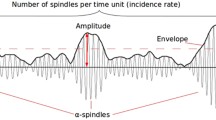Abstract
Methodologic and clinical considerations are discussed in sensorimotor rhythm (SMR) biofeedback research on two dissimilar but severe epileptic males. The first case, an akinetic epileptic who prior to feedback training experienced 80–100 clinical seizures every 10 hours, showed considerable seizure reduction after 6 months of SMR and epileptiform training. A number of methodologic and instrumentation advances were pioneered with the akinetic patient: (1) development of and ultra-sharp band-pass filter; (2) use of epileptiform inhibit and feed-back circuitry; (3) use of monetary rewards as additional incentive; (4) use of correlational analysis for evaluation of acquisition in the major dependent variables and; (5) use of noncontingent feedback and rein-forcement as control techniques. The second case, a psychomotor epileptic, also showed therapeutic benefit from SMR training. Clinical information regarding the effect of anticonvulsant medications on the course and therapeutic outcome of SMR training are described. In conjunction with operant conditioning of 12 Hz activity, corresponding changes for other EEG parameters are examined.
Similar content being viewed by others

References
Allison, T.:In M. B. Sterman (chair),EEG Operant Conditioning in the Treatment of Epilepsy: Research Methods and Clinical Fndings. Symposium presented at the 16th Annual Meeting of the Pavlovian Society, Los Angeles, 1975.
Finley, W. W.: Effects of sham feedback following successful SMR training in an epileptic: Follow-up study.Biofeedback and Self-Regulation 1:227–235, 1976.
Finley, W. W., Smith, H. A., and Etherton, M. D.: Reduction of seizures and normalization of the EEG in a severe epileptic following sensorimotor biofeedback training: preliminary study.Biol. Psychol.,2:189–203, 1975.
Kaplan, B. J.: Biofeedback in epileptics: Equivocal relationship of reinforced EEG frequency to seizure reduction.Epilepsia,16:427–489, 1975.
Leff, D. N.: Epilepsy: Improving the picture for patients.Med. World News,16:47–58, 1975.
Lubar, J. F. and Bahler, W. W.: Behavioral management of epileptic seizures following EEG biofeedback training of the sensorimotor rhythm.Biofeed-back and Self-Regulation,1:77–104, 1976.
Seifert, A. R. and Lubar, J. F.: Reduction of epileptic seizures through EEG biofeedback training.Biol. Psychol.,3:157–184, 1975.
Sterman, M. B.: Clinical implications of EEG biofeedback training: a critical appraisal.In J. Beatty (Ed.)Biofeedback: Theory and Research, New York: Academic Press, 1975.
Sterman, M. B., Macdonald, L. R., and Stone, R. K.: Biofeedback training of the sensorimotor EEG rhythm in man: effects on epilepsy.Epilepsia 15: 395–416, 1974.
Author information
Authors and Affiliations
Rights and permissions
About this article
Cite this article
Finley, W.W. Operant conditioning of the EEG in two patients with epilepsy: Methodologic and clinical considerations. Pav. J. Biol. Sci. 12, 93–111 (1977). https://doi.org/10.1007/BF03004497
Issue Date:
DOI: https://doi.org/10.1007/BF03004497



